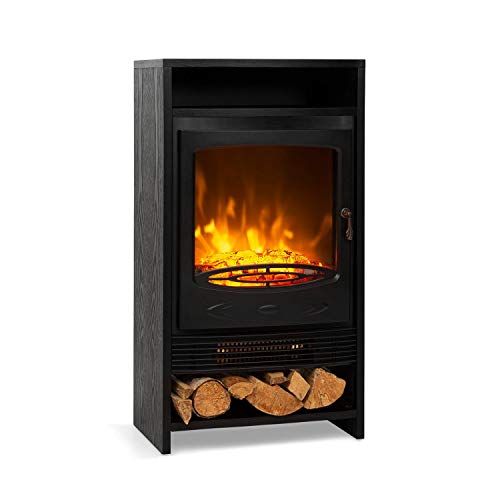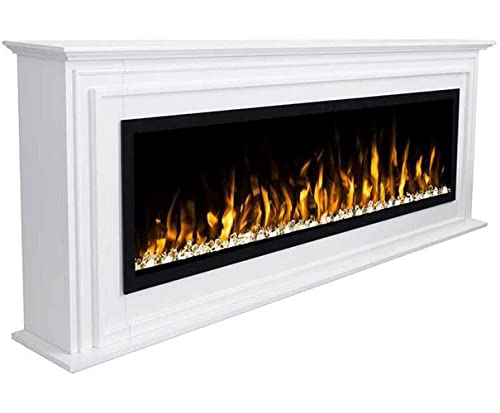
Fireplaces And Stoves
Add a reviewOverview
-
Sectors Graphic Design
-
Posted Jobs 0
-
Viewed 1331
Company Description
The 10 Scariest Things About Wood Burner Fireplace
How to Get the Most From a Wood Burner Fireplace
Wood stoves, in contrast to traditional open fireplaces, are designed to use wood for combustion. This allows them meet the stricter emission requirements.
Wood burning stoves emit dancing yellow flames and cosy crackling noises. They also provide a primal feeling of warmth. However the smoke they release is contaminated with carbon monoxide as well as toxic air pollutants like benzene, formaldehyde and polycyclic aromatic hydrocarbons.
Efficient
Fireplaces and stoves that burn wood provide a beautiful and natural heat to the home, they are also extremely efficient. A high-quality wood burner can achieve an Ecodesign rating of up to 77%. With the increasing cost of energy, it is crucial to ensure you are getting the maximum benefits from your log burner – the good news is that this is more simple than ever before!
A key factor in the efficiency of the wood-burning stove is will be the water content of the wood. We recommend using only well-seasoned wood that has been dried over a period of at least one year and in some cases, two years. The dryer the wood is the more efficiently it burns which results in less smoke and harmful emissions.
A wood burning stove also has the benefit of being an environmentally friendly fuel source, which is great for the environment. In addition, by buying locally sourced firewood you are helping to support the management of woodlands which is a wonderful thing for wildlife.
The only thing a wood burning stove needs in terms of maintenance is to take away and get rid of the ash. It can be a bit of a hassle but it’s worth it to ensure you get the most heat from every log. If you wait for the ashes 2-3 days to cool completely, they can also be utilized as a non-toxic and eco-friendly ice melt. They can also be used to polish jewellery or absorb the odors.
 A wood burner fireplace is a timeless classic. Although they are less popular than gas fireplaces, their appeal and ambiance of a roaring flame cannot be ignored. These fires are perfect to cuddle in on cold winter nights, and create a warm and welcoming space in your home. Making the investment in a top-quality wood burner will pay for itself for a long time. Our chimney sweeps are here to assist you in getting the most out of your stove. Give us a call today to find out more.
A wood burner fireplace is a timeless classic. Although they are less popular than gas fireplaces, their appeal and ambiance of a roaring flame cannot be ignored. These fires are perfect to cuddle in on cold winter nights, and create a warm and welcoming space in your home. Making the investment in a top-quality wood burner will pay for itself for a long time. Our chimney sweeps are here to assist you in getting the most out of your stove. Give us a call today to find out more.
Low Carbon
Wood burners that are efficient and clean are the most efficient way to save money while keeping your home warm. In addition, they can also assist in the local woodland management. It’s a fantastic way to support the wildlife that lives in your local area.
 Wood-burning fireplaces and stoves create very little pollution if they are properly maintained and operated with dry, seasoned and dry firewood. If they are not properly maintained or use wood that is of poor quality, the smoke that is produced is a result of fine particles, also known as particulate pollutants, which can irritate the lungs and other organs of the body. It also contains carbon monoxide as well as toxic air pollutants such as formaldehyde, benzene and polycyclic aromatic hydrocarbons. Inhaling this kind of air pollution can cause irritation to the lung as well as wheezing, coughing, and asthma attacks and may even cause serious health issues such as heart disease, cancer, or premature death.
Wood-burning fireplaces and stoves create very little pollution if they are properly maintained and operated with dry, seasoned and dry firewood. If they are not properly maintained or use wood that is of poor quality, the smoke that is produced is a result of fine particles, also known as particulate pollutants, which can irritate the lungs and other organs of the body. It also contains carbon monoxide as well as toxic air pollutants such as formaldehyde, benzene and polycyclic aromatic hydrocarbons. Inhaling this kind of air pollution can cause irritation to the lung as well as wheezing, coughing, and asthma attacks and may even cause serious health issues such as heart disease, cancer, or premature death.
Many are concerned that wood-burning stoves contribute to climate change, but this isn’t necessarily true. Burning wood is a carbon-neutral energy source. The tree absorbs carbon dioxide over its life. When burned carbon dioxide is released into the atmosphere.
The wood is sourced locally, which reduces the amount pollution that is released during transportation. It is also essential to use high quality woods that are seasoned and seasoned as they will provide an extended and even burn than softwoods.
Modern wood stoves, like the ones made by Charlton & Jenrick, emit significantly less pollutant than older stoves. They have been tested and certified to meet the 2020 EPA standards which are much more stringent than previous emissions limits.
To avoid the buildup of exhaust within your home, all wood-burning stoves should be vented fully to the outside. By keeping flames above the logs and ensuring that you use dry, seasoned wood, all our current clean burn and DEFRA exempt stoves are capable of producing very clear exhaust. They also have particulate levels 60 percent or less below the DEFRA limit.
A wood burning stove equipped with an acatalytic converter or hybrid unit can provide the best low-carbon solution for heating. These units re-ignite gases and particles released from the initial burning in a subsequent phase by mixing them with superheated air. They then funnel the remaining particulates and gasses through a catalytic combustion combustor for the third and final combustion, further decreasing emissions to levels well below government standards.
Clean Burn
Cleanburn wood stoves burn fuel at the highest possible efficiency. This results in the emission of minimal particles into the air when burning wood. The air management system of the stove controls the intake and ventilation of gases, ensuring that the combustion process takes place in a sealed and controlled environment. It also regulates the flame height to minimise emissions and maximise the heat output.
This means that your chimney and surrounding area will be a lot cleaner than older stoves. Particulate matter (also called particle pollution) from wood that is not fully combusted can cause respiratory problems like wheezing and coughing and can lead to the development of heart diseases, stroke, diabetes and other serious health conditions. Wood burning can also contribute to poor air quality in cities.
Smoke from poorly combusted wood is a source of fine particulate pollutants as well as harmful air pollutants such as carbon monoxide, as well as other dangerous air pollutants such as nitrogen oxides and volatile organic compounds (VOCs), benzene and formaldehyde. These particles can be absorbed into the lungs, and other organs, causing discomfort and injury, and even death. Airborne dust can also contaminate the surfaces in your home and give an unpleasant sludge-like feel to rooms.
It is important to select top quality, seasoned, and dried firewood for your fireplace with a wood burner. Hardwoods such as oak beech, ash and are the best for heating. Hardwoods have a higher density and BTU content. They also offer more heat than softwoods.
Check with your local authority to determine whether they have any regulations about wood burning. These rules may include rules on odors and nuisances, as well as visible emissions or smoke opacity restrictions.
If you have a wood burner with a glass door it is essential to keep the glass clean of dirt and deposits. You can use a dry cloth or oven cleaner spray for this. Alternatively, you can mix bicarbonate of a soda with a bit of water to the glass.
Regular maintenance is crucial for your chimney and stove. Regular chimney cleanings are necessary to eliminate creosote, and ensure that the flue is operating correctly. Also be sure to mark dates for regular inspections in your calendar, as this will help you avoid costly repairs and extend the life of your wood burner.
Low Maintenance
Many people prefer installing wood-burning fireplaces due to the natural warmth they create. However, this kind of fire requires some care and maintenance. The chimney, flue and stove can all be the cause of house fires if not maintained and cleaned regularly. These fireplaces are also an excellent source of warmth when the power goes out, especially during winter, when snow storms could cause tree branches to fall and rip up power lines.
If you use a wood stove to heat your home, you’ll be able to reduce your carbon footprint compared to other fossil sources of fuel like gas. Modern wood stoves and inserts have been designed to meet EPA (Environmental Protection Agency) standards, which means they emit very little carbon dioxide. The more well-seasoned wood is and the better it is, the more efficient it will be as well, so you’ll burn less of it to produce the same amount of heat.
These fireplaces require some upkeep and attention, including making sure they are positioned away from combustible materials and a screen is in place. Making sure the grate is free of ash and debris will allow airflow and prevent the fire from dying out too quickly and keep your indoors clean. It is recommended that your stove and chimney swept every year at least two times to prevent the build-up of creosote which could create an extremely dangerous fire hazard as well as a blockage that can hinder ventilation.
A wood-burning stove will need to be kept in good order and it could take some time for a beginner homeowner to learn how to light, ignite and maintain a constant fire in the fireplace. Once you’ve learned the art of lighting, your wood burning stove will be an ideal source of warmth and comfort within your home.
Fireplaces that burn wood have been around in one form or another for more than 500 years and they’ve regained popularity due to their energy efficiency and sustainability, as well as the natural warmth and scent of real wood. If you’re thinking of buying a new heater, talk with your local certified Regency dealer to find out more about the benefits of a wood stove or insert for your home.
